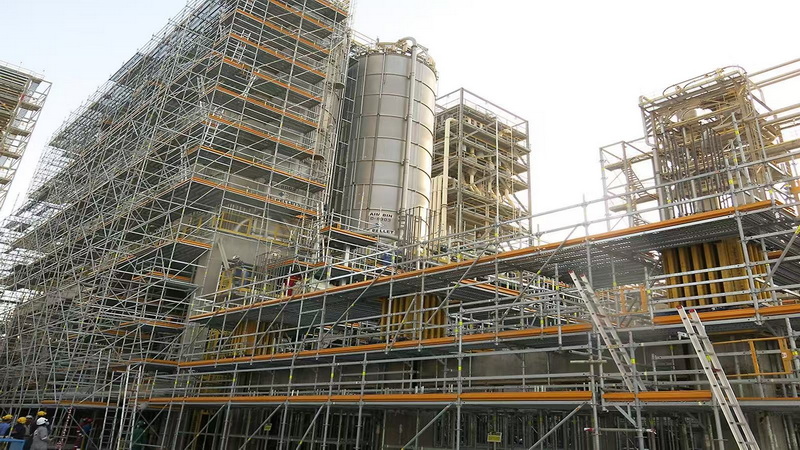Content Menu
● Overview of Scaffold Ops Management Systems
● Key Features of Scaffold Ops Management Systems
● Benefits of Using a Scaffold Ops Management System
>> Enhanced Efficiency
>> Improved Safety
>> Better Decision Making
● Applications of Scaffold Ops Management Systems
● Best Practices for Implementing a Scaffold Ops Management System
>> Detailed Planning
>> Proper Training
>> Regular Maintenance
>> Integration with Other Systems
● Case Studies
>> Case Study 1: Large-Scale Construction Project
>> Case Study 2: Industrial Maintenance Project
● Advanced Features and Technologies
● Conclusion
● FAQ
>> 1. What are the primary benefits of using a scaffold ops management system?
>> 2. How does a scaffold ops management system improve safety?
>> 3. Can a scaffold ops management system be integrated with other management software?
>> 4. How does a scaffold ops management system enhance productivity?
>> 5. Is training required for using a scaffold ops management system?
● Citations:
A scaffold ops management system is a comprehensive digital solution designed to streamline and optimize scaffolding operations within construction and industrial settings. This system integrates various aspects of scaffolding management, including planning, execution, and monitoring, to enhance efficiency, safety, and productivity. In this article, we will explore the key benefits of using a scaffold ops management system and discuss its features, applications, and advantages.

Overview of Scaffold Ops Management Systems
Scaffold ops management systems are advanced software solutions that automate the entire lifecycle of scaffolding operations. They provide a centralized platform for managing scaffolding requests, approvals, production, and inventory, ensuring safety and efficiency throughout the process.
Key Features of Scaffold Ops Management Systems
- Automated Scaffolding Operation Life Cycle: These systems create detailed plans for scaffolding erection, maintenance, and dismantling, including scheduling tasks and allocating resources.
- Inventory Management: They enable tracking and managing scaffolding equipment and materials, including inventory levels, usage, and procurement.
- Resource Allocation: The software assigns personnel and equipment to specific tasks, optimizing resource utilization and minimizing downtime.
- Safety Compliance: Many systems incorporate safety features, such as safety checklists, hazard assessments, and compliance tracking, ensuring adherence to safety regulations.
- Reporting and Analytics: Advanced reporting and analytics capabilities provide insights into productivity metrics, performance trends, and areas for improvement.
Benefits of Using a Scaffold Ops Management System
Implementing a scaffold ops management system offers several benefits:
Enhanced Efficiency
1. Streamlined Operations: By automating manual processes, these systems reduce the time spent on planning and execution, allowing for faster project completion.
2. Optimized Resource Allocation: The ability to assign resources effectively ensures that personnel and equipment are utilized efficiently, minimizing idle time and enhancing productivity.
Improved Safety
1. Compliance Tracking: The system ensures that all scaffolding operations adhere to safety standards, reducing the risk of accidents and regulatory issues.
2. Regular Inspections: It facilitates regular inspections and maintenance checks, ensuring that scaffolding equipment remains in good condition.
Better Decision Making
1. Data Analytics: The system provides real-time data and analytics, enabling informed decisions about resource allocation, project timelines, and safety protocols.
2. Performance Monitoring: It allows for continuous monitoring of productivity metrics and performance trends, helping identify areas for improvement.
Applications of Scaffold Ops Management Systems
These systems are versatile and can be applied in various scenarios:
- Construction Projects: Ideal for residential and commercial building projects where efficient scaffolding management is crucial.
- Industrial Maintenance: Useful in industrial settings for managing scaffolding operations during repairs and maintenance tasks.
- Event Staging: Can be used to streamline scaffolding setup for temporary structures such as concert stages or exhibition platforms.

Best Practices for Implementing a Scaffold Ops Management System
To fully leverage the benefits of a scaffold ops management system, consider implementing these best practices:
Detailed Planning
Ensure that every phase of the scaffolding process, from erection to dismantling, includes detailed timelines, resource allocation, and task dependencies. Coordination with other project activities is essential to minimize downtime.
Proper Training
Train all personnel involved in scaffolding operations to use the software effectively. This includes understanding how to update actions in emergencies and manage safety protocols.
Regular Maintenance
Conduct routine inspections and maintenance of scaffolding equipment to ensure uninterrupted operations. Immediate repair of faulty mechanisms is crucial for maintaining efficiency.
Integration with Other Systems
Integrate the scaffold ops management system with other management software, such as project management or inventory management systems, to streamline workflows and enhance data exchange.
Case Studies
To illustrate the effectiveness of scaffold ops management systems in real-world applications, let's examine a few case studies:
Case Study 1: Large-Scale Construction Project
In a recent large-scale construction project, contractors faced challenges with managing scaffolding resources efficiently. By implementing a scaffold ops management system, they were able to streamline operations significantly. The system allowed for real-time tracking of equipment and personnel, reducing downtime by over 20% and enhancing overall project efficiency.
Case Study 2: Industrial Maintenance Project
During routine maintenance work in an industrial setting, engineers needed a system to optimize scaffolding operations while ensuring safety compliance. The scaffold ops management system provided a centralized platform for managing requests, approvals, and inspections, ensuring that all operations met regulatory standards. As a result, they reduced project timelines by 15% while maintaining high safety standards.
Advanced Features and Technologies
Modern scaffold ops management systems often incorporate advanced technologies to further enhance efficiency and safety:
- IoT Sensors: These sensors can be used to collect real-time data on scaffolding conditions, providing insights into potential hazards or wear.
- Wearable Technology: Wearable devices can monitor worker activity, enhancing safety by detecting potential risks and alerting management.
- Mobile Apps: Mobile applications allow for on-site access to critical information, enabling workers to update records and report issues in real-time.
Conclusion
A scaffold ops management system offers a comprehensive solution for optimizing scaffolding operations, enhancing efficiency, safety, and productivity. By automating manual processes, providing real-time data analytics, and ensuring compliance with safety regulations, these systems play a crucial role in modern construction and industrial projects.
As construction demands continue to evolve, systems like these will remain integral in providing reliable management solutions while boosting operational efficiency and safety.

FAQ
1. What are the primary benefits of using a scaffold ops management system?
The primary benefits include enhanced efficiency, improved safety, and better decision-making capabilities through data analytics.
2. How does a scaffold ops management system improve safety?
It ensures compliance with safety regulations, facilitates regular inspections, and tracks maintenance activities to prevent accidents.
3. Can a scaffold ops management system be integrated with other management software?
Yes, many systems offer integration capabilities with project management software, inventory management systems, or safety management systems to streamline workflows.
4. How does a scaffold ops management system enhance productivity?
By automating manual processes, optimizing resource allocation, and providing real-time data analytics, it helps identify areas for improvement and streamline operations.
5. Is training required for using a scaffold ops management system?
Yes, proper training is essential for all personnel involved in using the system to ensure effective utilization and adherence to safety protocols.
Citations:
[1] https://techehs.com/blog/measure-productivity-of-your-scaffolding-operations
[2] https://coreehs.com/software/scaffolding-management-software/
[3] https://www.linkedin.com/pulse/how-scaffolding-management-software-can-boost-efficiency-cloudscaff
[4] https://cloudscaff.com
[5] https://layherna.com/5-scaffolding-considerations/
[6] https://techehs.com/software/scaffolding-management-software
[7] https://www.plantengineering.com/articles/scaffolding-systems-can-support-a-higher-level-of-productivity/
[8] https://www.avontus.com/blog/must-haves-scaffold-rental-management-software/






















